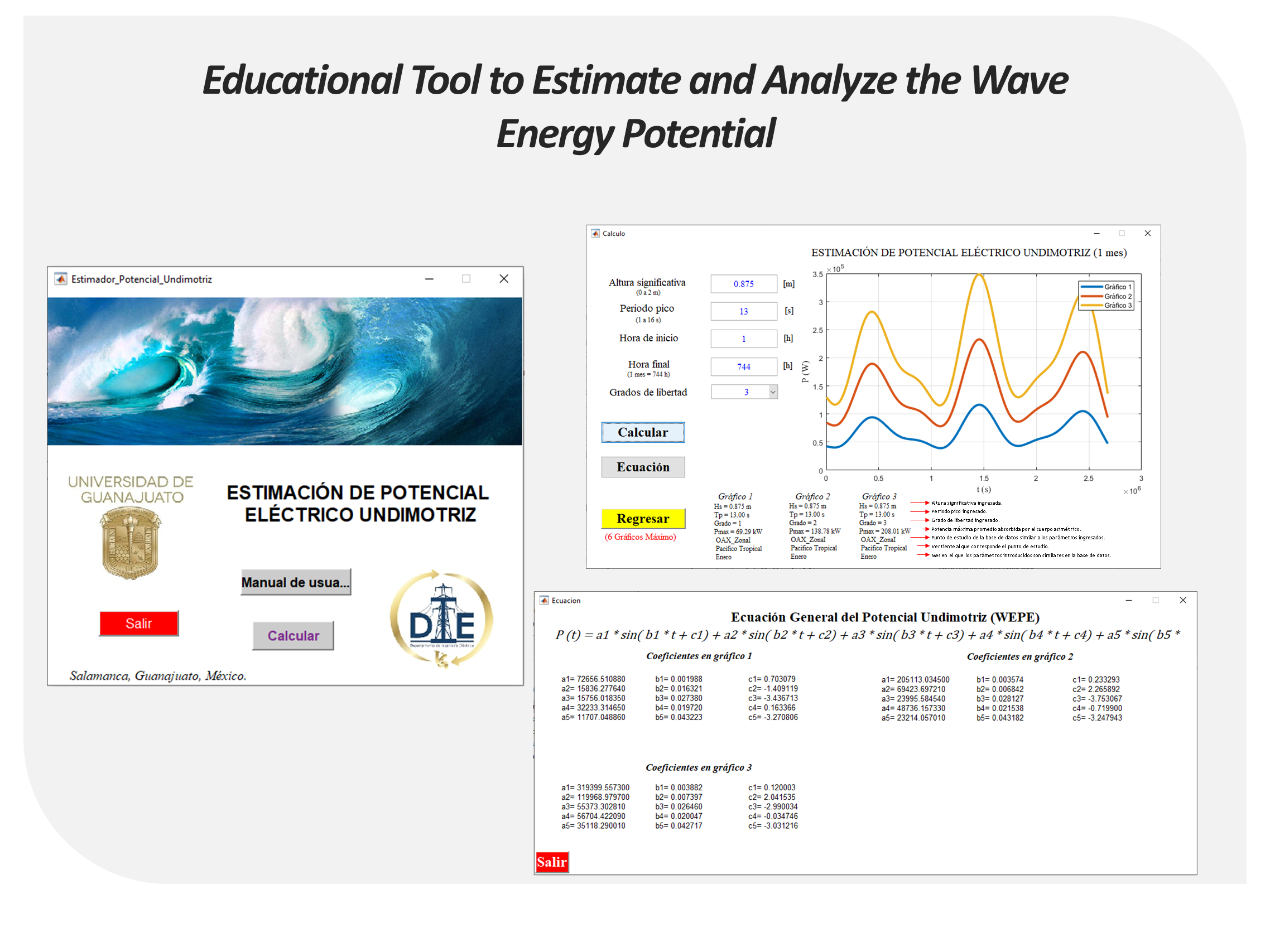Educational Tool to Estimate and Analyze the Wave Energy Potential
Keywords:
Bigdata, microgrid, ocean waves, renewable source, sustainability, wave energy potential.Abstract
In order to search new alternatives for electric power generation, the study of the wave energy potential was considered in this work, it deals with the develop for academic and research purposes an executable tool capable of providing the wave energy potential in any point of interest in the coastal zone of Mexico. To develop this tool, the main parameters were used: the significant height of the wave and its period. These parameters were obtained from an easily accessible oceanographic from the National Oceanic and Atmospheric Administration (NOAA) over a period of 6 years. The large database was statistically processed to obtain a reference base and applying numerical techniques for curve fitting, it was possible to obtain a characteristic equation to emulate the wave movement, this emulating model allows estimating the wave energy potential as a function of time and most attached to reality. This work contributes in the academic part in the estimation of wave energy potential, their visualization and understanding, to be a tool in the design of microgrids with renewables.
Downloads
References
World Energy Council. (2017). World Energy Trilemma Index 2017: Monitoring the Sustainability of National Energy Systems. London.
Zhou, M. (25 de Julio de 2013). World Energy Consumption to Increase 56% by 2040 Led by Asia. Bloomberg.
Altintas K., Turk T., Vayvay O. (2016), Renewable Energy for a Sustainable Future, Turquía, Marmara Journal of Pure and Applied Sciences.
Oviedo-Salazar, J. L., Badii M. H., Guillen A., Lugo Serrato O. (2015). History and Use of Renewable Energies. Daena: International Journal of Good Conscience.
Casarín, R. S. (2017). Anual report an overview of ocean energy activities in 2017. Ocean Energy Sistems (OES), 12, 19.
Stahl A. (1892). The utilization of the power of occean waves. Trans Am Soc Mech Eng, 13: 438 - 506.
Hayward, J., Behrens, S., McGarry, S., & Osman, P. (2012). Economic modelling of the potential of wave energy. Renewable Energy, 48.
Saket, A., & Etemad-Shahidi, A. (2012). Wave energy potential along the northern coasts of the Gulf of Oman, Iran. Renewable Energy, 40.
Fadaeenejad, M., Shamsipour, R., Rokni, S., & Gomes, C. (2014). New approaches in harnessing wave energy: With special attention to small islands. ELSEVIER: Renewable and Sustainable Energy Reviews.
Fernández Díez, P. F. (2005). Energía de las olas. Universidad de Cantabria: Departamento de Ingeniería eléctrica y energética. Obtenido de Energía del mar: http://es.pfernandezdiez.es/libro/?id=5
J. Falnes, “Ocean waves and oscillating systems” En ISBN 0-511-03093-2. Inglaterra: Cambridge University press, 2002.
J. Falnes, “A review of wave-energy extraction” Elsevier: Marine Structures, pp. 186 – 200, 2007.
González-Ramírez X., Hernández-Robles I. A. y Barrios-Piña H. (2017). Potencial energético undimotriz en nodos costeros de México, Parte 1: estimación energética, Tecnología y Ciencias del Agua, vol. VIII, 11,10.
Pessanha J. F. M., Melo A. C. G., Caldas R. P and Falcão D. M.(2020) An Approach for Data Treatment of Solar Photovoltaic Generation. IEEE Latin America Transactions, vol. 18, nO. 9, sept 2020.
Gonzalez X., Guzman Cabrera R. Hernandez I.A., Guzman Sepulveda J. R., (2022) Statidistical technique to improve potential estimation for the design of wave generators. Energy Conversion and Management X. ELSEVIER, vol. 14, sept 2022.
MathWorks. (2006). Curve Fitting. Obtenido de MathWorks: https://la.mathworks.com/help/curvefit/curvefitting-app.html.
MathWorks. (2019). Gaussian Models. Obtenido de MathWorks: https://la.mathworks.com/help/curvefit/gaussian.html.
Google My Maps (2016). Mapa de los mares mexicanos. Recuperado de https://www.google.com/maps/d/edit.
Chapra, S. C. (2007). Métodos numéricos para ingenieros Quinta edición. ISBN-13: 978-970-10-6114-5: McGRAW-HILL/INTERAMERICANA EDITORES.
MathWorks. (2019). Fourier Series. Obtenido de MathWorks: https://la.mathworks.com/help/curvefit/fourier.html.
MathWorks. (2019). Exponential Models. Obtenido de MathWorks: https://la.mathworks.com/help/curvefit/exponential.html.
MathWorks. (2019). Sum of Sines Models. Obtenido de MathWorks: https://la.mathworks.com/help/curvefit/sum-of-sine.html.
Castellano A.O., Lago R.D., Bory H., (2022). Programa para determinar los parámetros que caracterizan el oleaje marino y simular su comportamiento. Ingeniería Hidráulica y Ambiental, vol. XLIII, No. 2, Abr-Jun 2022, p. 29-43.
Hernandez-Robles I.A., Gonzalez-Ramirez X., Gomez J., Ramirez J.M., (2021). Wave power assessment for electricity generation with powerbouy system by wave motion emulation modelling. Sustainable Energy Technologies and Assessments, vol. 43, 2021, p. 1-12.


